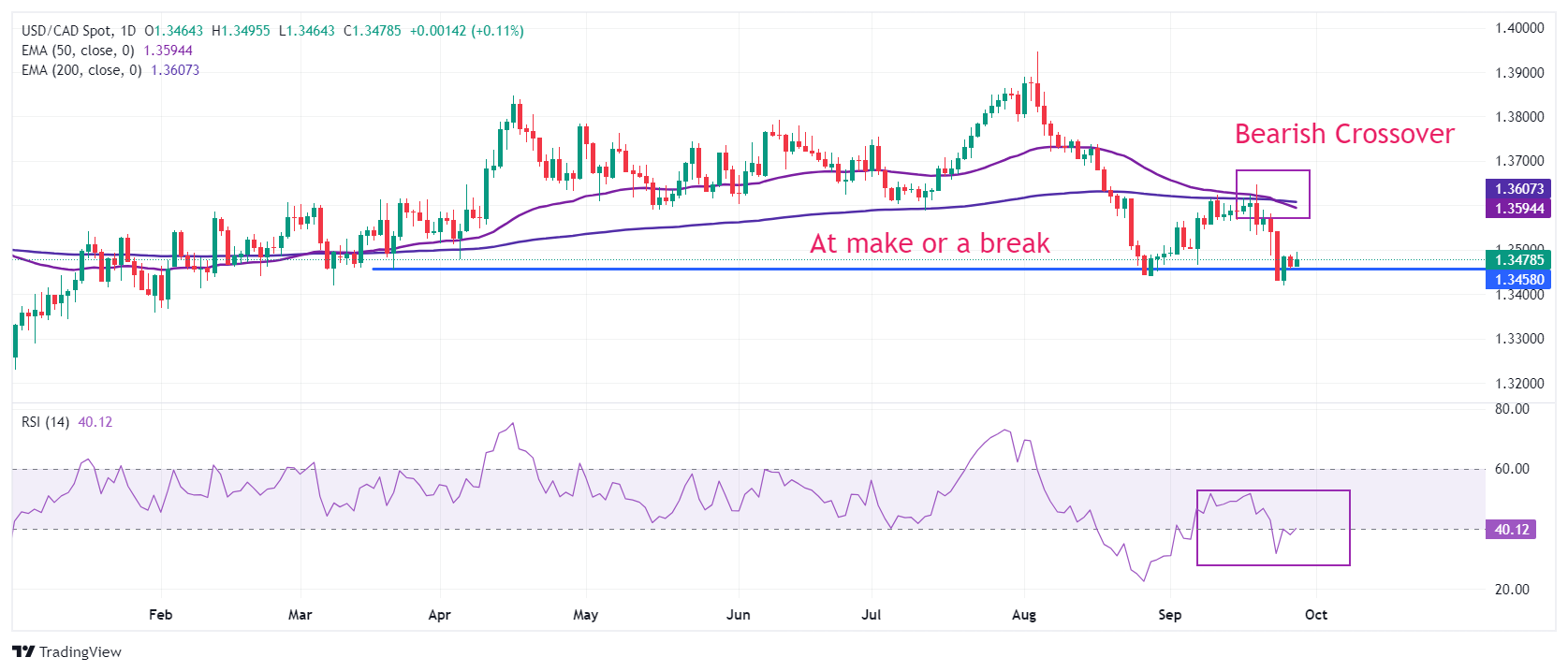- USD/CAD is cautious below 1.3500 ahead of data from the US and Canada.
- Economists estimate that the Canadian economy grew 0.1% in July.
- US PCE inflation will influence market expectations for the Fed’s interest rate outlook.
The USD/CAD pair trades cautiously below the psychological resistance of 1.3500 in the European session on Friday. The Loonie asset is marginally higher despite a slight decline in the US Dollar (USD), suggesting weakness in the Canadian Dollar (CAD) ahead of July’s monthly Gross Domestic Product (GDP) data, which They will be published at 12:30 GMT.
The Canadian economy is estimated to have barely grown after remaining flat in June. The Bank of Canada (BoC) is expected to extend its policy easing cycle due to the trend of slowing inflation and weakening labor market conditions.
At the same time, the main release will be the United States (US) personal consumption expenditure (PCE) price index for August. Core PCE inflation, a preferred inflation indicator of the Federal Reserve (Fed), is estimated to have grown 2.7%, faster than the 2.6% in July year-over-year.
Core inflation data will significantly influence the Fed’s interest rate outlook for the final quarter of the year. Financial market participants expect the Fed to cut interest rates by 75 basis points, combined, in the remaining two policy meetings.
USD/CAD is trading at an inflection point above the immediate support of 1.3400. The main formed a new swing low near 1.3400 on a daily time frame, suggesting a bearish trend. A bearish crossover, represented by the 20-day and 50-day EMAs near 1.3600, indicates more declines ahead.
The 14-day Relative Strength Index (RSI) delivers a range reversal move in the territory of 20.00-60.00 from 40.00-80.00, suggesting that pullbacks would be considered as selling opportunities by investors.
Going forward, further correction of the main below the immediate support of 1.3400 would expose it to the January 31 low of 1.3360 and June 9 low of 1.3340.
In an alternative scenario, a recovery move above the psychological support of 1.3500 would take the asset towards the April 5 low of 1.3540, followed by the September 20 high of 1.3590.
USD/CAD daily chart
The Canadian Dollar FAQs
The key factors that determine the price of the Canadian Dollar (CAD) are the level of interest rates set by the Bank of Canada (BoC), the price of oil, Canada’s main export product, the health of its economy, inflation and the trade balance, which is the difference between the value of Canadian exports and its imports. Other factors are market confidence, that is, whether investors bet on riskier assets (risk-on) or look for safe assets (risk-off), with the risk-on being positive for the CAD. As its largest trading partner, the health of the US economy is also a key factor influencing the Canadian dollar.
The Bank of Canada (BoC) exerts significant influence over the Canadian Dollar by setting the level of interest rates that banks can lend to each other. This influences the level of interest rates for everyone. The BoC’s main objective is to keep inflation between 1% and 3% by adjusting interest rates up or down. Relatively high interest rates are usually positive for the CAD. The Bank of Canada can also use quantitative easing and tightening to influence credit conditions, with the former being negative for the CAD and the latter being positive for the CAD.
The price of oil is a key factor influencing the value of the Canadian Dollar. Oil is Canada’s largest export, so the price of oil tends to have an immediate impact on the value of the CAD. Generally, if the price of oil rises, the CAD also rises, as aggregate demand for the currency increases. The opposite occurs if the price of oil falls. Higher oil prices also tend to lead to a higher probability of a positive trade balance, which also supports the CAD.
Although inflation has traditionally always been considered a negative factor for a currency, as it reduces the value of money, the opposite has actually happened in modern times, with the relaxation of cross-border capital controls. Higher inflation often leads central banks to raise interest rates, attracting more capital inflows from global investors looking for a lucrative place to store their money. This increases the demand for the local currency, which in the case of Canada is the Canadian Dollar.
The published macroeconomic data measures the health of the economy and may have an impact on the Canadian dollar. Indicators such as GDP, manufacturing and services PMIs, employment and consumer confidence surveys can influence the direction of the CAD. A strong economy is good for the Canadian dollar. Not only does it attract more foreign investment, but it may encourage the Bank of Canada to raise interest rates, resulting in a stronger currency. However, if economic data is weak, the CAD is likely to fall.
Source: Fx Street
I am Joshua Winder, a senior-level journalist and editor at World Stock Market. I specialize in covering news related to the stock market and economic trends. With more than 8 years of experience in this field, I have become an expert in financial reporting.








